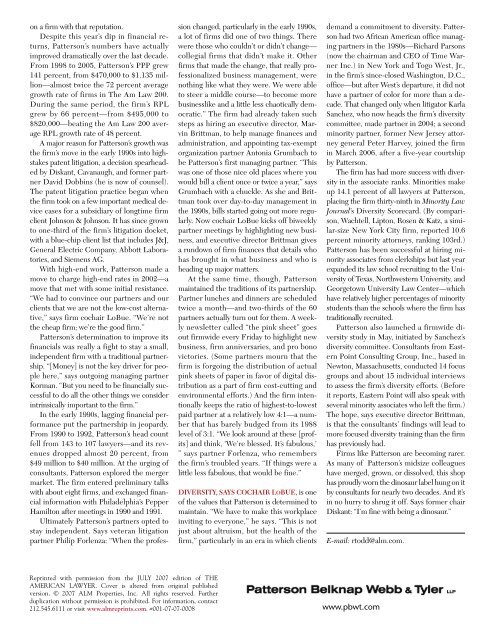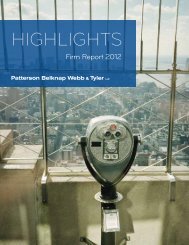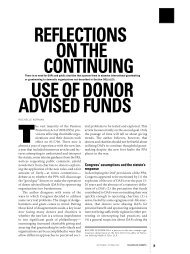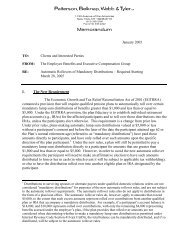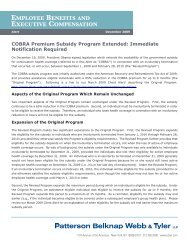THE ROAD LESS TRAVELED - Patterson Belknap Webb & Tyler LLP
THE ROAD LESS TRAVELED - Patterson Belknap Webb & Tyler LLP
THE ROAD LESS TRAVELED - Patterson Belknap Webb & Tyler LLP
You also want an ePaper? Increase the reach of your titles
YUMPU automatically turns print PDFs into web optimized ePapers that Google loves.
on a firm with that reputation.<br />
Despite this year’s dip in financial returns,<br />
<strong>Patterson</strong>’s numbers have actually<br />
improved dramatically over the last decade.<br />
From 1998 to 2005, <strong>Patterson</strong>’s PPP grew<br />
141 percent, from $470,000 to $1.135 million—almost<br />
twice the 72 percent average<br />
growth rate of firms in The Am Law 200.<br />
During the same period, the firm’s RPL<br />
grew by 66 percent—from $495,000 to<br />
$820,000—beating the Am Law 200 average<br />
RPL growth rate of 48 percent.<br />
A major reason for <strong>Patterson</strong>’s growth was<br />
the firm’s move in the early 1990s into highstakes<br />
patent litigation, a decision spearheaded<br />
by Diskant, Cavanaugh, and former partner<br />
David Dobbins (he is now of counsel).<br />
The patent litigation practice began when<br />
the firm took on a few important medical device<br />
cases for a subsidiary of longtime firm<br />
client Johnson & Johnson. It has since grown<br />
to one-third of the firm’s litigation docket,<br />
with a blue-chip client list that includes J&J,<br />
General Electric Company, Abbott Laboratories,<br />
and Siemens AG.<br />
With high-end work, <strong>Patterson</strong> made a<br />
move to charge high-end rates in 2002—a<br />
move that met with some initial resistance.<br />
“We had to convince our partners and our<br />
clients that we are not the low-cost alternative,”<br />
says firm cochair LoBue. “We’re not<br />
the cheap firm; we’re the good firm.”<br />
<strong>Patterson</strong>’s determination to improve its<br />
financials was really a fight to stay a small,<br />
independent firm with a traditional partnership.<br />
“[Money] is not the key driver for people<br />
here,” says outgoing managing partner<br />
Korman. “But you need to be financially successful<br />
to do all the other things we consider<br />
intrinsically important to the firm.”<br />
In the early 1990s, lagging financial performance<br />
put the partnership in jeopardy.<br />
From 1990 to 1992, <strong>Patterson</strong>’s head count<br />
fell from 143 to 107 lawyers—and its revenues<br />
dropped almost 20 percent, from<br />
$49 million to $40 million. At the urging of<br />
consultants, <strong>Patterson</strong> explored the merger<br />
market. The firm entered preliminary talks<br />
with about eight firms, and exchanged financial<br />
information with Philadelphia’s Pepper<br />
Hamilton after meetings in 1990 and 1991.<br />
Ultimately <strong>Patterson</strong>’s partners opted to<br />
stay independent. Says veteran litigation<br />
partner Philip Forlenza: “When the profession<br />
changed, particularly in the early 1990s,<br />
a lot of firms did one of two things. There<br />
were those who couldn’t or didn’t change—<br />
collegial firms that didn’t make it. Other<br />
firms that made the change, that really professionalized<br />
business management, were<br />
nothing like what they were. We were able<br />
to steer a middle course—to become more<br />
businesslike and a little less chaotically democratic.”<br />
The firm had already taken such<br />
steps as hiring an executive director, Marvin<br />
Brittman, to help manage finances and<br />
administration, and appointing tax-exempt<br />
organization partner Antonia Grumbach to<br />
be <strong>Patterson</strong>’s first managing partner. “This<br />
was one of those nice old places where you<br />
would bill a client once or twice a year,” says<br />
Grumbach with a chuckle. As she and Brittman<br />
took over day-to-day management in<br />
the 1990s, bills started going out more regularly.<br />
Now cochair LoBue kicks off biweekly<br />
partner meetings by highlighting new business,<br />
and executive director Brittman gives<br />
a rundown of firm finances that details who<br />
has brought in what business and who is<br />
heading up major matters.<br />
At the same time, though, <strong>Patterson</strong><br />
maintained the traditions of its partnership.<br />
Partner lunches and dinners are scheduled<br />
twice a month—and two-thirds of the 60<br />
partners actually turn out for them. A weekly<br />
newsletter called “the pink sheet” goes<br />
out firmwide every Friday to highlight new<br />
business, firm anniversaries, and pro bono<br />
victories. (Some partners mourn that the<br />
firm is forgoing the distribution of actual<br />
pink sheets of paper in favor of digital distribution<br />
as a part of firm cost-cutting and<br />
environmental efforts.) And the firm intentionally<br />
keeps the ratio of highest-to-lowest<br />
paid partner at a relatively low 4:1—a number<br />
that has barely budged from its 1988<br />
level of 3:1. “We look around at these [profits]<br />
and think, ‘We’re blessed. It’s fabulous,’<br />
” says partner Forlenza, who remembers<br />
the firm’s troubled years. “If things were a<br />
little less fabulous, that would be fine.”<br />
Diversity, says cochair LoBue, is one<br />
of the values that <strong>Patterson</strong> is determined to<br />
maintain. “We have to make this workplace<br />
inviting to everyone,” he says. “This is not<br />
just about altruism, but the health of the<br />
firm,” particularly in an era in which clients<br />
demand a commitment to diversity. <strong>Patterson</strong><br />
had two African American office managing<br />
partners in the 1980s—Richard Parsons<br />
(now the chairman and CEO of Time Warner<br />
Inc.) in New York and Togo West, Jr.,<br />
in the firm’s since-closed Washington, D.C.,<br />
office—but after West’s departure, it did not<br />
have a partner of color for more than a decade.<br />
That changed only when litigator Karla<br />
Sanchez, who now heads the firm’s diversity<br />
committee, made partner in 2004; a second<br />
minority partner, former New Jersey attorney<br />
general Peter Harvey, joined the firm<br />
in March 2006, after a five-year courtship<br />
by <strong>Patterson</strong>.<br />
The firm has had more success with diversity<br />
in the associate ranks. Minorities make<br />
up 14.1 percent of all lawyers at <strong>Patterson</strong>,<br />
placing the firm thirty-ninth in Minority Law<br />
Journal’s Diversity Scorecard. (By comparison,<br />
Wachtell, Lipton, Rosen & Katz, a similar-size<br />
New York City firm, reported 10.6<br />
percent minority attorneys, ranking 103rd.)<br />
<strong>Patterson</strong> has been successful at hiring minority<br />
associates from clerkships but last year<br />
expanded its law school recruiting to the University<br />
of Texas, Northwestern University, and<br />
Georgetown University Law Center—which<br />
have relatively higher percentages of minority<br />
students than the schools where the firm has<br />
traditionally recruited.<br />
<strong>Patterson</strong> also launched a firmwide diversity<br />
study in May, initiated by Sanchez’s<br />
diversity committee. Consultants from Eastern<br />
Point Consulting Group, Inc., based in<br />
Newton, Massachusetts, conducted 14 focus<br />
groups and about 15 individual interviews<br />
to assess the firm’s diversity efforts. (Before<br />
it reports, Eastern Point will also speak with<br />
several minority associates who left the firm.)<br />
The hope, says executive director Brittman,<br />
is that the consultants’ findings will lead to<br />
more focused diversity training than the firm<br />
has previously had.<br />
Firms like <strong>Patterson</strong> are becoming rarer.<br />
As many of <strong>Patterson</strong>’s midsize colleagues<br />
have merged, grown, or dissolved, this shop<br />
has proudly worn the dinosaur label hung on it<br />
by consultants for nearly two decades. And it’s<br />
in no hurry to shrug it off. Says former chair<br />
Diskant: “I’m fine with being a dinosaur.”<br />
E-mail: rtodd@alm.com.<br />
Reprinted with permission from the JULY 2007 edition of The<br />
American Lawyer. Cover is altered from original published<br />
version. © 2007 ALM Properties, Inc. All rights reserved. Further<br />
duplication without permission is prohibited. For information, contact<br />
212.545.6111 or visit www.almreprints.com. #001-07-07-0008 www.pbwt.com


